Thailand is famous for its night markets, temples, cheap eats, and majestic beaches, but surfing… in Thailand, really?
Yep. Believe it or not, you can catch some pretty rad waves in the Land of Smiles.
But not all beaches offer equal swell. You need to know where to surf and the best time of year to visit.
Here's a definitive guide to the best surfing in Thailand, by area, beach, months, coast length and wave height.
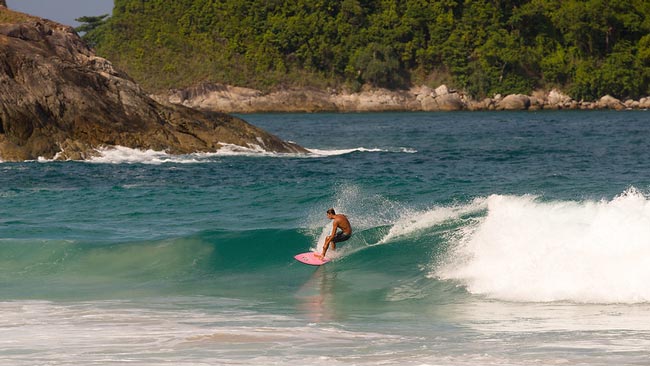
Nai Harn Beach. Image Credit: Phuket @ photographer.net
Phuket
Phuket has the most surfing available, so let's start with Thailand's largest island.
1. Bang Tao Beach
Bang Tao Beach is a five-mile crescent-shaped stretch that boasts the Laguna Phuket, one of the biggest resort complexes in Asia.
Situated between Patong Beach and the airport, it is the second-longest beach in Phuket and is widely considered a go-to destination in Phuket for those who are learning to surf and those of an intermediate standard.
The northern part of the beach has larger waves, especially when blessed by winds, while the central part has unpredictable waves that drop-off sharply at times.
Waves tend to get smaller towards the southern part, so pick a spot up the north end.
- Best Months: April to October
- Recommended For: beginner and intermediate
- Coast Length: 6000 meters
- Wave Height: up to 3 meters
=> I Stayed at the Best Western Bang Tao Hotel
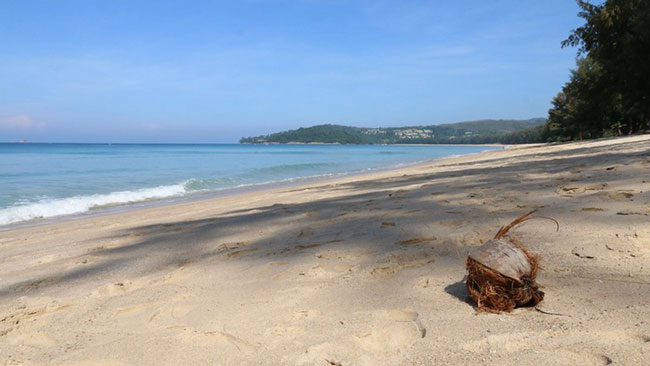
Bang Tao Beach gets choppier in the afternoon: Image credit: P Dean
2. Pansea Beach
Pansea Beach is situated on the west coast of Phuket and lies between the beaches of Bang Tao and Surin.
This secluded beach blessed with an abundance of palm trees is one of Thailand’s smallest beaches.
Despite the short stretch, the waves can be aggressive, tending to speed up before crashing into a left-hander.
The take-off is around 100 meters away from the shore and is marked by a rock exposed by the waters.
This surfing spot should be on any professional surfer’s go-to list, as the waves are held for 2 meters in a point break before turning into a reef break.
- Best Months: April to October
- Recommended For: Advanced
- Coast Length: 250 meters
- Wave Height: 2 meters
3. Surin Beach
Surin Beach was once featured by CNN Travel in their list of the World's 50 Best Surf Spots, and recently it has become synonymous with bodyboarding.
The beach flaunts white sand and turquoise waters, along with large rocks in the middle part of the waters – so locate those before you paddle out.
Fast and short waves tend to be unpredictable in the northern stretch, thus making the left and right-handers rather challenging, even for those who are experienced in swimming and surfing.
Hence, the southern part suits the inexperienced surfer, since the landing to the sandy bottom is safer.
If you are a seasoned surfer, challenge yourself and practice your barrels in the northern part, but if you're not very experienced stay southern.
- Best Months: April to October
- Recommended For: beginner to intermediate (southern end); advanced (northern end)
- Coast Length: 80 meters
- Wave Height: 2 meters
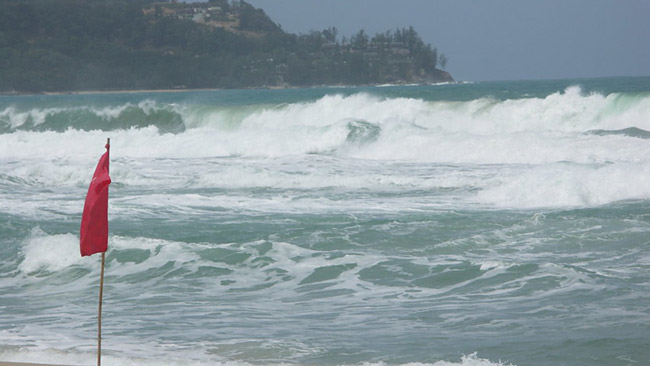
The waves at Surin Beach can get pretty tasty. Careful of those Rip Tides! Image credit:Geoff Leeming
4. Kalim Beach
The rocky Kalim Beach lies north of Patong Beach and is the venue for the Kalim Surf Contest organized by the Kalim Reef Surfers.
The contest often takes place in mid-September, so expect a bigger crowd if you visit during that time.
Thanks to the right-hand reef break, you can enjoy a long ride of 100 meters, but just be cautious as you reach the shallow reef- especially when it’s below mid-tide.
It is best to go surfing along Kalim Beach during the low season, since the place gets pretty crowded.
Once you have finished surfing, you can enjoy some noodle soup, Thai ice cream, and other delicacies from the stands at the back of the beach.
- Best Months: April to October
- Recommended For: Intermediate and advanced
- Coast Length: 100 meters
- Wave Height: 3 meters
5. Kamala Beach
Situated to the north of Patong Beach, Kamala Beach offers spectacular views.
Here you will find the Kamala Go Surfing Club, the group that holds the annual Kamala Go Surfing Challenge, usually held in July.
The most challenging part of the northern end of the beach is the hard reef point break and unpredictable waves. The southern end suits kids who are learning to surf.
For the most part the waves tend to be pretty fast, and left and right-handers stay consistent.
- Best Months: April to October
- Recommended For: beginner (southern end); intermediate and advanced (northern end)
- Coast Length: 2100 meters
- Wave Height: 1 meter (southern end); 3 meters (middle part)
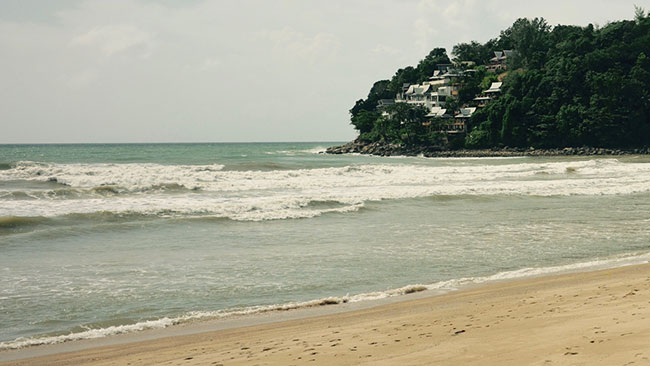
Kamala Beach can produce consistent waves, but not very high. Image credit: Matthew Colvin de Valle
6. Kata Beach
Kata Beach is undoubtedly the most popular surfing spot in Phuket, given the number of bars, schools, rental shops, and a park all dedicated to surfing. This surfer's shack is where the annual Phuket Surfing Contest is held – in September.
Kata Beach suits all proficiencies of surfer from beginner through advanced. The southern part offers swells that can pose a moderate amount of challenge for pros but can also be a good learning curve for beginners.
Waves go up to 2 meters high due to an A-frame beach break.
- Best Months: April to October
- Recommended For: all levels
- Coast Length: 1500 meters
- Wave Height: 2 meters
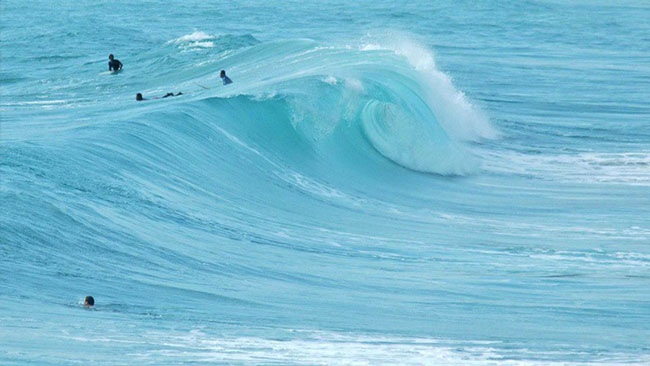
A barrel at Kata Beach. image credit: Bryan Nys
7. Nai Harn Beach
Nai Harn Beach in Phuket’s southern tip is famous for producing large swells even during low tide. Considered a favorite by local pros, it boasts a less crowded beach with a sandbank that lets surfers enjoy fast waves in smaller swells too.
The northern end promises an A-frame peak and challenging break, while the southern end offers long rides that end with a left-hand break. Both are fun.
The beach is perfect for swimming from November to April but waves are too big during the rest of the year, thus making the waters attractive to surfers and kite boarders.
- Best Months: April to October
- Recommended For: advanced
- Coast Length: 660 meters
- Wave Height: 3 meters
Koh Lanta
8. Klong Dao Beach
Undisputedly the best surfing destination on the island of Koh Lanta, Klong Dao Beach has breaks that can be surfed regardless of high or low tides.
The right and left-handers are not too strong, making the beach a decent choice for beginners. Despite its popularity, Klong Dao is never over crowded due to its 250-kilometer distance from Phuket.
Other activities you can enjoy here are long-boarding and standup paddle-boarding, since the depth is fairly shallow.
The only catch about Klong Dao is that the waves are not that consistent, so you might need to wait that bit longer to catch a big wave.
- Best Months: April to October
- Recommended For: Beginner and intermediate
- Coast Length: 2000 meters
- Wave Height: 2 meters
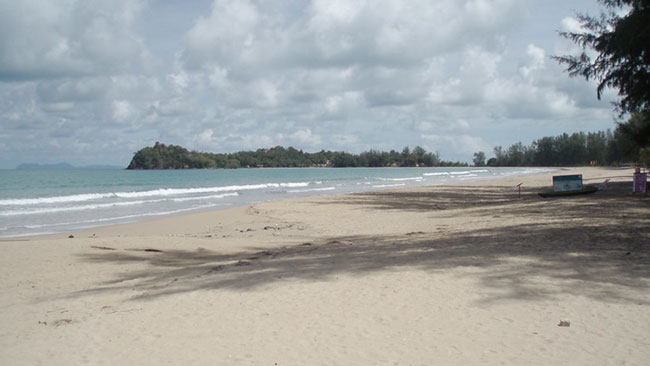
Go to beautiful Klong Dao from April to October. Image credit: Marhas1 @ Flikr
Khao Lak
9. Na Nan, Nang Thong, Bang Niang
Located sixty kilometers from Phuket, Khao Lak is secluded but its surf scene is on the rise.
The Khao Lak Surf Contest and Festival held during October lures surfers to visit the 25-kilometer coastline of Khao Lak.
Breaks vary from reef, point, and beach, as the coastline has capes and reef in addition to lovely sandy beaches.
The beaches here include Na Nan, Nang Thong, and Bang Niang among others.
Surfing season in Khao Lak can be anytime from May to October, but the peak season is when the southwest monsoon is strongest, and that is from June to September.
- Best Months: June to September
- Recommended For: all levels
- Coast Length: 25,000 meters
- Wave Height: 0.5 to 3 meters
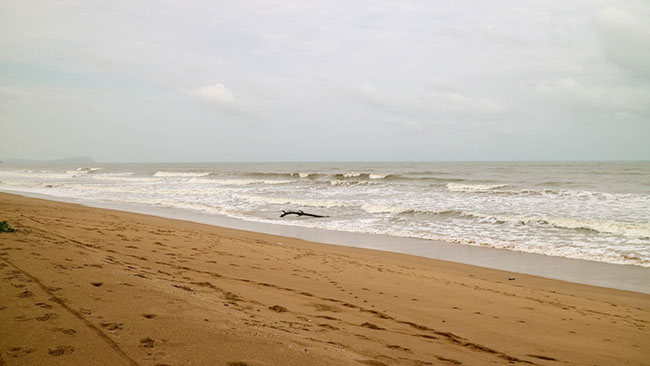
Khao Lak beach is long with some decent waves. Image credit: Sheila Dee
Koh Samui
10. Chaweng Beach
Chaweng Beach isn’t particularly famous for surfing in Thailand, but it is no doubt one of Koh Samui’s top beach destinations because of the beautiful views and the party vibe.
In Koh Samui, Chaweng is the go-to place for surfing because the other beaches are mostly only fit for swimming.
Surfing along Chaweng Beach is made easier due to the number of board rental shops lined near the shoreline.
Surfing here can be tricky though, as the tide may look suitable from afar but may tend to be too low once you get in the water.
The beach break during mid or high tide gives a long left-hander perfect for longboarding and standup paddleboarding.
- Best Months: November to February
- Recommended For: Intermediate to advanced
- Coast Length: 7000 meters
- Wave Height: 1 meter
=> Read: 15 Best Things to Do in Koh Samui
Koh Phangan
11. Haad Rin, Ban Tai, Chaloklum
Just like Koh Samui, Koh Phangan normally has flat waves perfect for swimming, since both are facing the Gulf of Thailand, so don’t be surprised if you come across people saying that you're wasting your time trying to surf here.
However, if you visit during the right months you can catch some decent swells. Ban Tai’s reef break from November onwards offers clean swells and long rides while Haad Rin is the best spot in January for short runs.
The best surf spot for consistent wave rolls is Chaloklum during December.
- Best Months: November to February
- Recommended For: All levels
- Coast Length: 7000 meters
- Wave Height: 1 meter
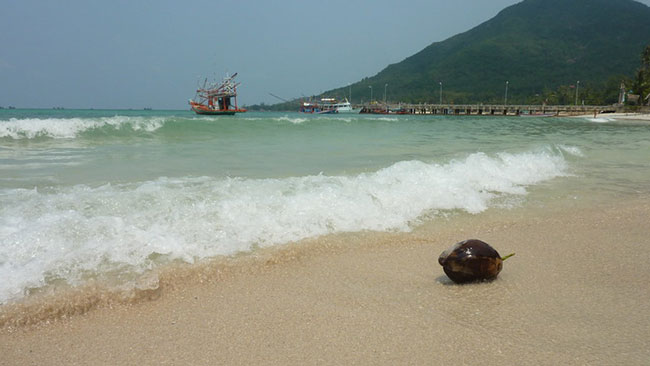
Chaloklum Beach has some decent rolls in December. Image credit: Cédric Liénart
Hua Hin
12. Khao Takiab, Wanakorn Beach
Surfing spots in Phuket are best visited from April to October. To catch a few waves in winter months check out Hua Hin.
Thailand’s western surf spots get swell from the southwest summer monsoon, but the Gulf of Thailand and easterly spots get swell from the northeast winter monsoon that blows across from China and Japan.
Thing is, the winter swell is smaller and less consistent, but it's worth a shot if you're up that way.
It’s worth remembering that the winter swell is a lot less powerful and consistent than that of the summer.
Note that the main Hua Hin beach is a popular kitesurfing spot, so try Khao Takiab instead if you want surfing only.
Note that jelly fish can be more of an issue on this side of Thailand, so ask a local what the situation is at the time. The waters generally aren't as appealing, too.
- Best Months: November to February
- Recommended For: all levels
- Coast Length: 20,000 meters
- Wave Height: 0.5 to 1.5 meters
=> Read: What to Do in Hua Hin – A Long Weekend
Rayong
13. Mae Ram Phueng Beach
Rayong is becoming increasingly popular with the surfing community, as evident in the number of shops offering board rentals and surfing lessons, as well as the local surfing competitions popping up here and there.
It is not too far from Bangkok – unlike the other surfing hubs scattered on the western and eastern coasts – making it an easy place to get to from the capital.
The waves roll pretty slowly and are usually low to moderate, making it easy for beginners to improve their stance.
Rayong’s main surfing beach is Mae Ram Phueng. For those into longboarding and standup paddleboarding can enjoy the small waves in Khao Laem Ya National Park, which is nearby.
- Best Months: May to September
- Recommended For: All levels
- Coast Length: 12,000 meters
- Wave Height: 0.5 to 2 meters
Chanthaburi
14. Laem Sing, Kung Wiman, Chao Lao
Chanthaburi is less than 4 hours from Bangkok, so if you’re in for a quick surfing getaway it may be the best choice.
Kung Wiman and Chao Lao are the notable surf beaches during certain months of the year (June to September). Laem Sing is also worth a shot, featuring a sandbar that creates a break into small rollers.
Check out Nature Active Camp, an event organized by the Chanthaburi Surf Tribe and Surfaholic Thailand for an unforgettable yoga and surfing experience.
- Best Months: June to September
- Recommended For: Beginner and intermediate
- Coast Length: 25,000 meters
- Wave Height: 0.5 to 1.5 meters
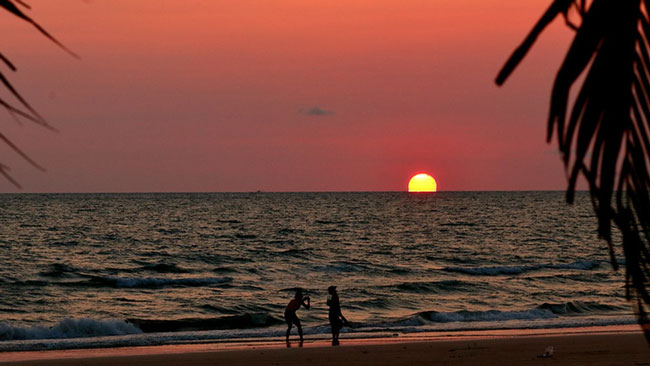
Surf & then watch the sun go down at Chao Lao beach. Image credit: Thomas Depenbusch
Koh Phayam
15. Ao Yai Beach
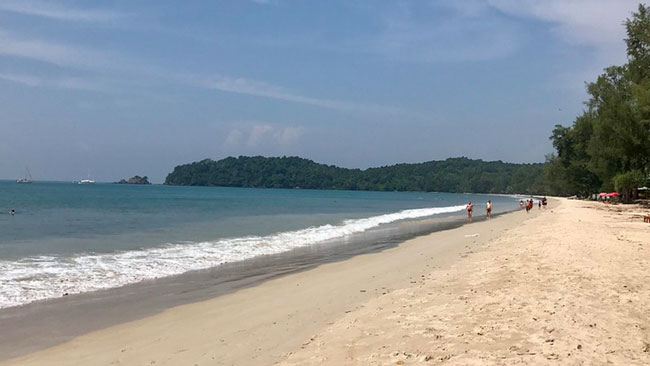
Ao Yai: A beautiful secluded beach. image credit: Paul Arps
Koh Phayam is an island blessed with the perfect waves during the pre-winter months.
It is largely undeveloped, so if you’re uncomfortable with a little isolation and a lack of amenities it won't suit you.
The island is fantastic for outdoor exploration but don't go wandering off into the jungle on your own!
The main surfer's beach in Koh Phayam is Ao Yai Beach. It is perfectly located to catch swells from the Andaman Sea.
The waves in October to mid-December are beginner-friendly and they get smaller until January. There's no waves between February and March.
The real fun starts with the monsoon season in mid-April. Waves go up to two-meters and potentially beyond, but the wind makes the conditions unpredictable and is best suited to experienced surfers.
- Best Months: Mid-October to mid-December (beginner and intermediate); mid-April (advanced)
- Recommended For: All levels
- Coast Length: 2000 meters
- Wave Height: 0.5 to 2 meters
Tips to Start Planning Your Trip Now
Book Your Accommodation:
For the best hotel rates in Thailand get quotes at Agoda and Hotels.com.
Don’t Forget Travel Insurance:
Travel insurance protects you against illness, injury, theft, and cancellations. I never travel without it. I use SafetyWing, and you should too.
Want to See Some Beaches?
Check out these 14 unspoiled beaches.
Last Updated on
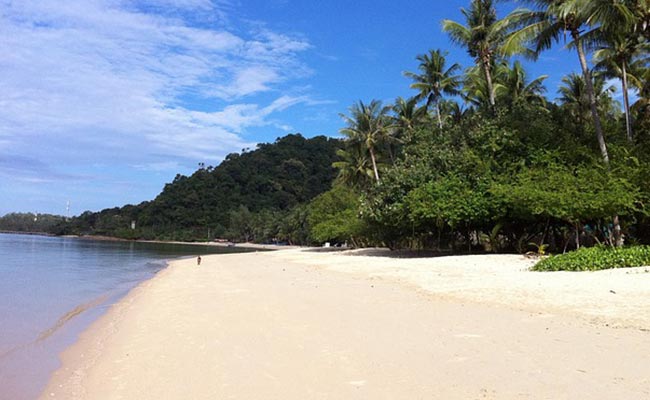
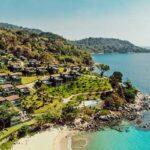
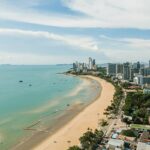
Leave a Reply